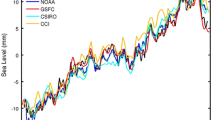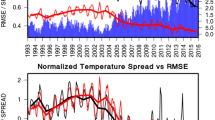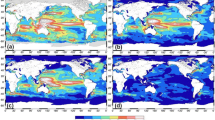Abstract
Quantifying the effect of the seawater density changes on sea level variability is of crucial importance for climate change studies, as the sea level cumulative rise can be regarded as both an important climate change indicator and a possible danger for human activities in coastal areas. In this work, as part of the Ocean Reanalysis Intercomparison Project, the global and regional steric sea level changes are estimated and compared from an ensemble of 16 ocean reanalyses and 4 objective analyses. These estimates are initially compared with a satellite-derived (altimetry minus gravimetry) dataset for a short period (2003–2010). The ensemble mean exhibits a significant high correlation at both global and regional scale, and the ensemble of ocean reanalyses outperforms that of objective analyses, in particular in the Southern Ocean. The reanalysis ensemble mean thus represents a valuable tool for further analyses, although large uncertainties remain for the inter-annual trends. Within the extended intercomparison period that spans the altimetry era (1993–2010), we find that the ensemble of reanalyses and objective analyses are in good agreement, and both detect a trend of the global steric sea level of 1.0 and 1.1 ± 0.05 mm/year, respectively. However, the spread among the products of the halosteric component trend exceeds the mean trend itself, questioning the reliability of its estimate. This is related to the scarcity of salinity observations before the Argo era. Furthermore, the impact of deep ocean layers is non-negligible on the steric sea level variability (22 and 12 % for the layers below 700 and 1500 m of depth, respectively), although the small deep ocean trends are not significant with respect to the products spread.














Similar content being viewed by others
References
Abraham J et al (2013) A review of global ocean temperature observations: implications for ocean heat content estimates and climate change. Rev Geophys 51:450–483
Avsic T, Karstensen J, Send U, Fischer J (2006) Interannual variability of newly formed Labrador Sea Water from 1994 to 2005. Geophys Res Lett 33:L21S02
Balmaseda M et al (2015) The Ocean Reanalyses Intercomparison Project (ORA-IP). J Oper Oceanogr 7:31 (accepted for publication)
Balmaseda MA, Mogensen K, Weaver A (2012) Evaluation of the ECMWF ocean reanalysis system ORAS4. Q J R Meteorol Soc 139:1132–1161
Behringer D (2007) The global ocean data assimilation system at NCEP. In: 11th symposium on integrated observing and assimilation systems for atmosphere, oceans and land surface. American Meteorology Society
Blockley EW et al (2014) Recent development of the Met Office operational ocean forecasting system: an overview and assessment of the new Global FOAM forecasts. Geosci Model Dev Discuss 6(4):6219–6278. doi:10.5194/gmdd-6-6219-2013
Böning C, Dispert A, Visbeck M, Rintoul S, Schwarzkopf F (2008) The response of the Antarctic Circumpolar Current to recent climate change. Nat Geosci 1:864–869
Cabanes C et al (2013) The CORA dataset: validation and diagnostics of in-situ ocean temperature and salinity measurements. Ocean Sci 9:1–18
Cazenave A, Llovel W (2010) Contemporary sea level rise. Annu Rev Mar Sci 2:145–173
Chambers D (2006a) Observing seasonal steric sea level variations with GRACE and satellite altimetry. J Geophys Res 111:C03 010. doi:10.1029/2005JC004836
Chambers D, Bonin J (2012) Evaluation of release-05 GRACE time-variable gravity coefficients over the ocean. Ocean Sci 8:859–868
Chambers D, Schröter B (2011) Measuring ocean mass variability from satellite gravimetry. J Geodyn 52:333–343
Chambers DP (2006) Evaluation of new GRACE timevariable gravity data over the ocean. Geophys Res Lett 33:LI7603. doi:10.1029/2006GL027296
Chang Y, Zhang S, Rosati A, Delworth T, Stern W (2013) An assessment of oceanic variability for 1960–2010 from the GFDL ensemble coupled data assimilation. Clim Dyn 40:775–803
Chang Y-S, Rosati A, Vecchi GA (2014a) Basin patterns of global sea level changes for 2004–2007. J Mar Syst 80:115–124
Chang Y-S, Vecchi GA, Rosati A, Zhang S, Yang X (2014b) Comparison of global objective analyzed T-S fields of the upper ocean for 2008–2011. J Mar Syst 137:13–20
de Boyer Montégut C, Madec G, Fischer AS, Lazar A, Iudicone D (2004) Mixed layer depth over the global ocean: an examination of profile data and a profile-based climatology. J Geophys Res 109:c12003
Durack P, Wijffels S, Gleckler P (2014) Long-term sea-level change revisited: the role of salinity. Environ Res Lett 9:114017-1–114017-11
Speer K, Forget G (2013) Global distribution and formation of mode waters. In: Siedler G, Griffies SM, Gould J, Church JA (eds) Ocean circulation and climate: a 21st century perspective. International geophysics. Elsevier
Fujii Y, Nakaegawa N, Matsumoto S, Yasuda T, Yamanaka G, Kamachi M (2009) Coupled climate simulation by constraining ocean fields in a coupled model with ocean data. J Clim 22:5541–5557
Fukumori I (2002) A partitioned Kalman filter and smoother. Mon Weather Rev 130:1370–1383
Fukumori I, Raghunath R, Fu L, Chao Y (1999) Assimilation of TOPEX/POSEIDON data into a global ocean circulation model: How good are the results? J Geophys Res 104:25 647–25 665
Fukumori I, Wang O (2013) Origins of heat and freshwater anomalies underlying regional decadal sea level trends. Geophys Res Lett 40:563–567
Garcia-Garcia D, Chao B, Boy J-P (2010) Steric and mass-induced sea level variations in the Mediterranean Sea revisited. J Geophys Res 115:C12 016. doi:10.1029/2009JC005928
Gill A, Niiler PP (1973) The theory of the seasonal variability in the ocean. Deep-Sea Res 20:141–177
Gregory J et al (2013) Twentieth-century global-mean sea level rise: Is the whole greater than the sum of the parts? J Clim 26:4476–4499
Griffies S, Greatbatch R (2012) Physical processes that impact the evolution of global mean sea level in ocean climate models. Ocean Model 51:37–72
Griffies S et al (2014) An assessment of global and regional sea level for years 1993–2007 in a suite of interannual CORE-II simulations. Ocean Model 78:35–89
Guinehut S, Dhomps A, Larnicol G, Le Traon P-Y (2012) High resolution 3D temperature and salinity fields derived from in situ and satellite observations. Ocean Sci 8:845–857
Haines K, Valdivieso M, Zuo H, Stepanov V (2012) Transports and budgets in a 1/4 global ocean reanalysis 1989–2010. Ocean Sci 8:333–344
Hanna E et al (2013) Ice-sheet mass balance and climate change. Nature 498:51–59
Ingleby B, Huddleston M (2007) Quality control of ocean temperature and salinity profiles—historical and real-time data. J Mar Syst 65:158–175
IPCC (2013) Climate change 2013: The physical science basis. Contribution of working group I to the fifth assessment report of the intergovernmental panel on climate change. Cambridge University Press, Cambridge, UK and New York, NY, USA, 1535 pp
Ishii M, Kimoto M, Sakamoto K, Iwasaki S-I (2006) Steric sea level changes estimated from historical ocean subsurface temperature and salinity analyses. J Oceanogr 62:155–170
Ivchenko V, Danilov S, Sidorenko D, Schröter J, Wenzel M, Aleynik L (2008) Steric height variability in the Northern Atlantic on seasonal and interannual scales. J Geophys Res 113:C11 007. doi:10.1029/2008JC004836
Johnson G, Chambers D (2013) Ocean bottom pressure seasonal cycles and decadal trends from GRACE release-05: ocean circulation implications. J Geophys Res 118:4228–4240
Köhl A (2014) Evaluation of the GECCO2 ocean synthesis: transports of volume, heat and freshwater in the Atlantic. Q J R Meteorol Soc. doi:10.1002/qj.2347
Krishnamurti T, Kishtawal C, Zhang Z, Larow T, Bachiochi D, Williford E (2000) Multimodel ensemble forecasts for weather and seasonal climate. J Clim 13:4196–4216
Landerer F, Jungclaus J, Marotze J (2007) Regional dynamic and steric sea level change in response to the IPCC-A1B scenario. J Phys Oceanogr 37:296–312
Le Traon P, Nadal F, Ducet N (1998) An improved mapping method of multi-satellite altimeter data. J Atmos Ocean Technol 15:522–534
Lee T, Awaji T, Balmaseda M, Grenier E, Stammer D (2009) Ocean state estimation for climate research. Oceanography 22:160–167
Leuliette E, Miller W (2009) Closing the sea level rise budget with altimetry, Argo, and GRACE. Geophys Res Lett 36:L04 608. doi:10.1029/2008GL036010
Leuliette E, Willis J (2011) Balancing the sea level budget. Oceanography 24:122–129
Levitus S et al (2012) World ocean heat content and thermosteric sea level change (0–2000 m), 1955–2010. Geophys Res Lett 39:L10 603
Llovel W, Guinehut S, Cazenave A (2010) Regional and interannual variability in sea level over 20022009 based on satellite altimetry, Argo float data and GRACE ocean mass. Ocean Dyn 60:1193–1204
Lombard A, Garric G, Penduff T (2009) Regional patterns of observed sea level change: insights from a 1/4 global ocean/sea-ice hindcast. Ocean Dyn 59:433–449
Lombard A et al (2007) Estimation of steric sea level variations from combined GRACE and Jason-1 data. Earth Planet Sci Lett 254:194–202
Lowe J, Gregory J (2006) Understanding projections of sea level rise in a Hadley Centre coupled climate model. J Geophys Res 111:C11 014
Masuda S et al (2010) Simulated rapid warming of abyssal North Pacific waters. Science 329:319–322
Munk W (2003) Ocean freshening, sea level rising. Science 300:2041–2043
Nerem R, Chambers D, Choe C, Mitchum G (2010) Estimating mean sea level change from the TOPEX and Jason altimeter missions. Mar Geod 33:435–446
Piecuch C, Ponte R (2011) Mechanisms of interannual steric sea level variability. Geophys Res Lett 38:L15 605
Piecuch C, Quinn K, Ponte R (2013) Satellite-derived interannual ocean bottom pressure variability and its relation to sea level. Geophys Res Lett 40:3106–3110
Ponte RM (2006) Oceanic response to surface loading effects neglected in volume-conserving models. J Phys Oceanogr 36:426–434
Ponte RM (2012) An assessment of deep steric height variability over the global ocean. Geophys Res Lett 39:L04 601. doi:10.1029/2011GL050681
Purkey S, Johnson G (2010) Warming of global abyssal and deep Southern Ocean waters between the 1990s and 2000s: contributions to global heat and sea level rise budgets. J Clim 23:6336–6351
Purkey S, Johnson G (2013) Antarctic bottom water warming and freshening: contributions to sea level rise, ocean freshwater budgets, and global heat gain. J Clim 26:6105–6122
Quinn KJ, Ponte RM (2010) Uncertainty in ocean mass trends from GRACE. Geophys J Intern 181:762–768. doi:10.1111/j.1365-246X.2010.04508.x
Schott F, Brandt P (2007) Ocean circulation: mechanisms and impacts—past and future changes of meridional overturning, chap. In: Schmittner A, Chiang JCH, Hemming SR (eds) Circulation and deep water export of the subpolar North Atlantic during the 1990’s. American Geophysical Union, Washington, pp 91–118
Stammer D, Cazenave A, Ponte R, Tamisiea M (2013) Causes for contemporary regional sea level changes. Annu Rev Mar Sci 5:21–46
Stammer D et al (2010) Ocean information provided through ensemble ocean syntheses. In: Hall J, Harrison D, Stammer D (eds) Sustained ocean observations and information for society, OceanObs’09. ESA Publication WPP-306, September 2009, pp 21–25
Steiger J (1980) Tests for comparing elements of a correlation matrix. Psychol Bull 87:245–251
Storto A, Dobricic S, Masina S, Di Pietro P (2011) Assimilating along-track altimetric observations through local hydrostatic adjustments in a global ocean reanalysis system. Mon Weather Rev 139:738–754
Storto A, Masina S, Dobricic S (2013) Ensemble spread-based assessment of observation impact: application to a global ocean analysis system. Q J R Meteorol Soc 139:1842–1862
Storto A, Masina S, Dobricic S (2014) Estimation and impact of nonuniform horizontal correlation length scales for global ocean physical analyses. J Atmos Ocean Technol 31:2330–2349
Sukuki T, Ishii M (2011) Regional distribution of sea level changes resulting from enhanced greenhouse warming in the Model for Interdisciplinary Research on Climate version 3.2 version. Geophys Res Lett 38:L02 601
Toyoda T, Fujii Y, Yasuda T, Usui N, Iwao T, Kuragano T, Kamachi M (2013) Improved analysis of the seasonal-interannual fields by a global ocean data assimilation system. Theor Appl Mech Jpn 61:31–48
Weaver AT, Deltel C, Machu E, Ricci S, Daget N (2005) A multivariate balance operator for variational ocean data assimilation. Q J R Meteorol Soc 131:605–625
Willis J, Chambers D, Nerem R (2008) Assessing the globally averaged sea level budget on seasonal to interannual timescales. J Geophys Res 113(C06):015
Wunsch C, Heimbach P (2013) Ocean circulation and climate—a 21st century perspective, international geophysics series. In: Sielder G, Griffes S, Gould J, Church J, Church J (eds) Chapter 21: dynamically and kinematically consistent global ocean circulation and ice state estimates, vol 103. Academic Press, Elsevier, pp 553–579
Xue Y, Huang B, Hu Z, Kumar A, Wen C, Behringer D, Nadiga S (2011) An assessment of oceanic variability in the NCEP climate forecast system reanalysis. Clim Dyn 37:2511–2539
Yin J, Griffies S, Stouffer R (2010) Spatial variability of sea level rise in twenty-first century projections. J Clim 23:4585–4607
Yin Y, Alves O, Oke P (2011) An ensemble ocean data assimilation system for seasonal prediction. Mon Weather Rev 139:786–808
Acknowledgments
During the preparation of this article, our co-author Nicolas Ferry passed away. He was an active and supportive member of the ORA-IP and CLIVAR-GSOP activities. This work has received funding from the Italian Ministry of Education, University and Research and the Italian Ministry of Environment, Land and Sea under the GEMINA project and from the European Commission Copernicus program, previously known as GMES program, under the MyOcean and MyOcean2 projects. The authors thank the CLIVAR Project Office for supporting the participation in conferences and workshops for presenting preliminary results about the steric sea level comparison. Simon Good was supported by the Joint UK DECC/Defra Met Office Hadley Centre Climate Programme (GA01101). K.A. Peterson was supported by the UK Public Weather Service research programme. The GLORY2V3 reanalysis has been developed at Mercator Ocèan with the support of the European Commission funded projects MyOcean (FP7-SPACE-2007-1) and MyOcean2 (FP7-SPACE-2011-1). GRACE ocean data were processed by Don P. Chambers, supported by the NASA MEaSUREs Program, and are available at http://grace.jpl.nasa.gov. The authors would like to thank Don Chambers (USF) for his help in the correct use of gravimetry data. Mean sea level data were provided by the Sea Level Research Group, University of Colorado. The altimeter products were produced by Ssalto/Duacs and distributed by AVISO, with support from CNES (http://www.aviso.oceanobs.com/duacs/). The authors are also very grateful to three anonymous reviewers and the editor for their precious suggestions and valuable comments, and for the improvement of the quality of this paper.
Author information
Authors and Affiliations
Corresponding author
Additional information
This paper is a contribution to the special issue on Ocean estimation from an ensemble of global ocean reanalyses.
Appendix: Mathematical definitions
Appendix: Mathematical definitions
We briefly introduce in this Appendix some mathematical definitions that are used in the paper.
1.1 Signal-to-spread ratio
In order to evaluate how distinguishable is the climate signal of the reanalysis ensemble with respect to its uncertainty, we define the signal-to-spread ratio (\(SSR\)), or more generally, the signal-to-noise ratio of the ensemble for a generic parameter \(p\) as
with \(EM\) and \(ES\) being the ensemble mean and spread, respectively, and N being the ensemble size, with
Note that the ensemble spread is defined as the sample standard deviation. Values of \(SSR\) smaller (greater) than 1 indicate that the discrepancy of reanalyses is greater (less) than their mean signal.
1.2 Annual and seasonal decomposition
It is also useful to decompose the steric sea level signal onto the seasonal (annual and semi-annual) and linear trend (inter-annual) components. To do this, we assume that every time-series of the variable \(x\) be of the form:
where \(t\) is the time (in months), \(m\) is the linear trend, \(A_a\) and \(\varphi _a\) are the annual amplitude and angular phase, respectively, and \(A_s\) and \(\varphi _s\) are the semi-annual amplitude and angular phase and \(\varepsilon \) are the residuals. The decomposition is carried out by a least-squares fitting of Eq. (7), i.e. by minimizing the sum of \(\varepsilon ^2 (t)\).
The seasonal signal \(x_S\), introduced in the text in Sects. 3 and 4, is defined as the full signal minus the linear trend:
namely it corresponds to the detrended signal. Conversely, the inter-annual signal \(x_I\), is defined as the full signal to which the fitted seasonal signal is subtracted:
In the above definitions, only the complementary fitted signal is removed, while the residuals are always kept. Note that the time-series corresponding to the inter-annual and seasonal signals have the same length of the time-series of the full signal, implying that the same minimum values for testing the significance of the correlations apply.
1.3 Explained variance
The (percentage) explained variance of a component \(y\) with respect to the (total) component \(z\) is defined as
with \(VAR(...)\) being the variance operator. When the explained variance of the inter-annual signal is introduced (e.g. in Fig. 11), it means that the explained variance is calculated on the timeseries, after removal of the seasonal signal, for both components \(y\) and \(z\).
Rights and permissions
About this article
Cite this article
Storto, A., Masina, S., Balmaseda, M. et al. Steric sea level variability (1993–2010) in an ensemble of ocean reanalyses and objective analyses. Clim Dyn 49, 709–729 (2017). https://doi.org/10.1007/s00382-015-2554-9
Received:
Accepted:
Published:
Issue Date:
DOI: https://doi.org/10.1007/s00382-015-2554-9




